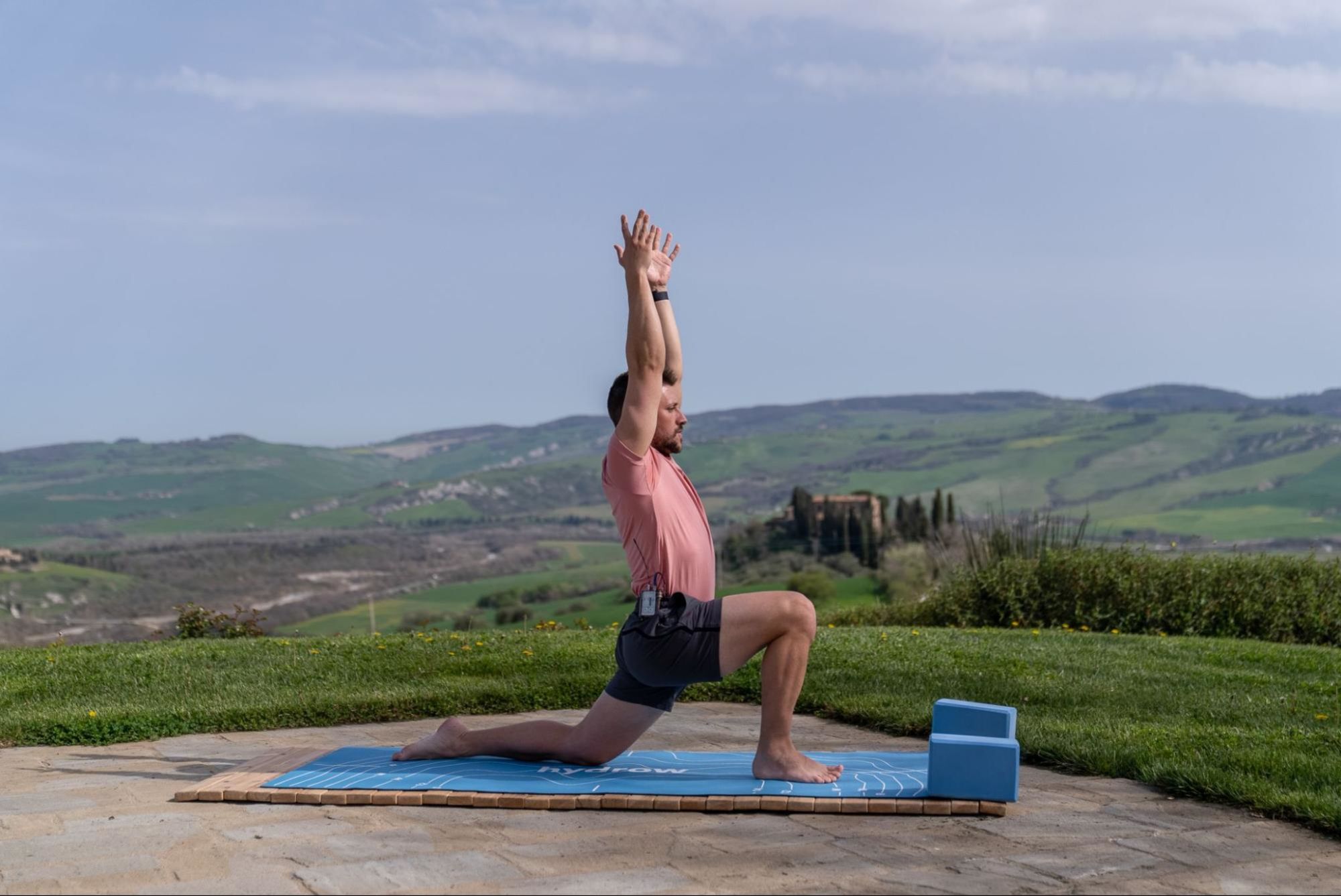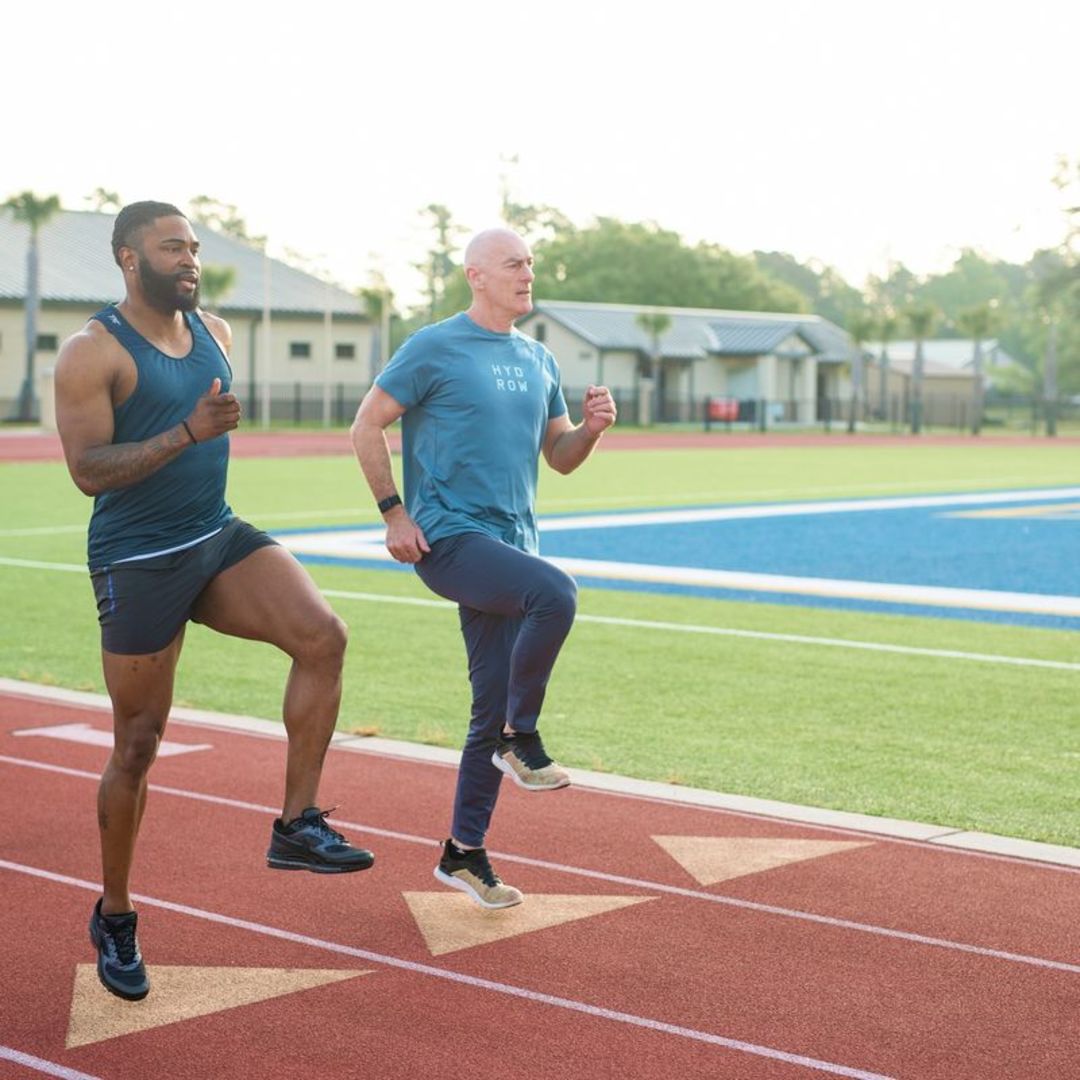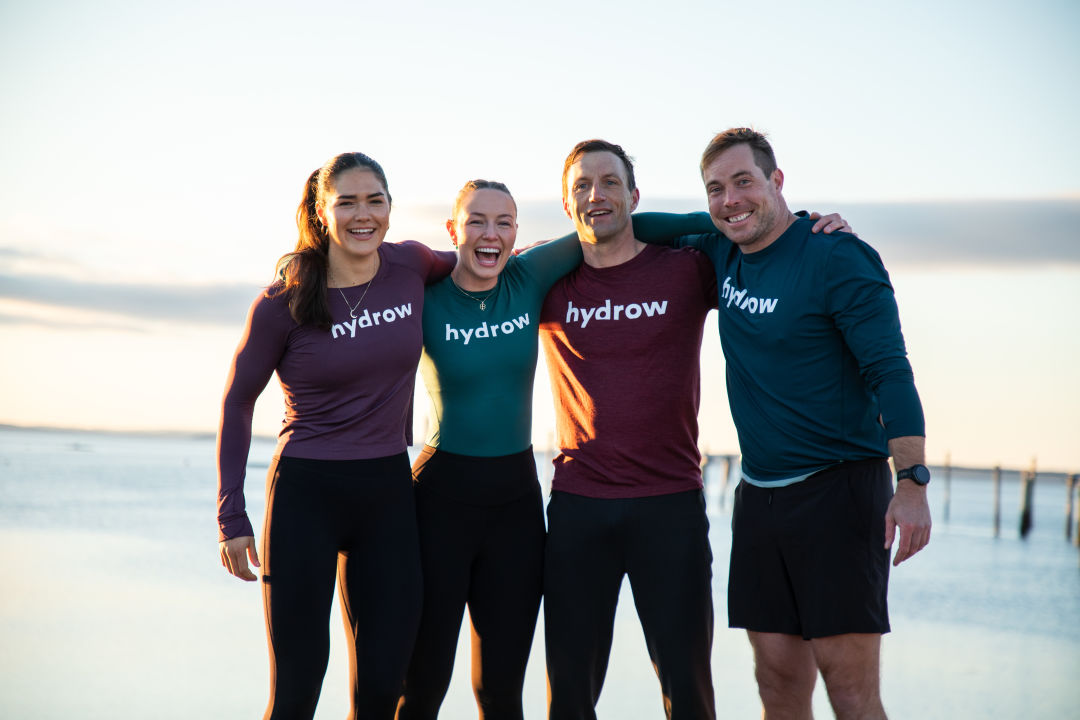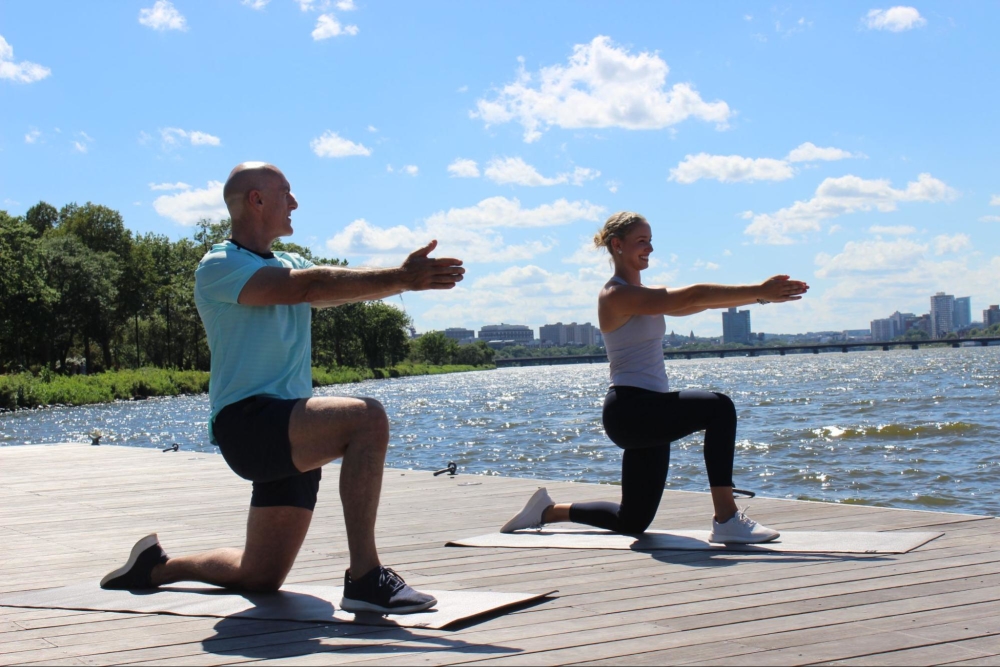What Is Vinyasa Yoga?

Vinyasa yoga is one of the most popular styles of yoga today. Characterized by its dynamic and flowing sequences of postures, it is sometimes referred to as "Vinyasa Flow" or simply "Flow.”
With so many different styles of yoga out there, it can be a bit overwhelming to find the one that best fits your own needs and goals. Here, we will take a closer look at:
Let’s get started!
What defines Vinyasa yoga?
Vinyasa as translated from Sanskrit means “to place in a special/particular way.” From that description alone, we begin to understand that Vinyasa yoga emphasizes deliberate movement. This refers to proper alignment within a pose (also called postures), controlled transitions between poses, and a thoughtful sequence of poses from start to finish.
Here are five distinct characteristics of Vinyasa that set it apart from other styles of yoga:
1. Synchronization of breath to movement
While all yoga emphasizes an awareness of breath and body, Vinyasa yoga syncs up breath to movement with more precision. Each movement is linked to an inhale or exhale. For example, in a Sun Salutation A, you inhale to reach the arms up, exhale to forward fold, inhale to a half-way lift, and exhale to a chaturanga push-up. This creates a predictable, rhythmic sequence of movement.
2. Continuous flow
While some styles of yoga are more restful or slow-moving, in Vinyasa yoga there is a continuous flow from one pose into the next. The transitions between poses are just as important as the poses themselves. This continuous flow makes for a solid physical workout as well as an easy way to calm the mind by focusing on nothing more than breathing and moving.
3. A variety of poses
During a 60-minute Vinyasa class, you might move through several dozen poses. These include backbends, forward folds, twists, inversions, and balancing poses. This variety keeps practitioners on their toes (sometimes literally!) and is distinct from other styles like Bikram that always include the same exact set of poses, or restorative classes that may only offer a few different supported poses held for long periods of time.

Explore Hydrow’s library of yoga workouts from around the world.
4. Creative sequencing
A “sequence” is exactly what it sounds like: the order in which poses are presented during a yoga class. Vinyasa yoga teachers have creative license to plan their sequence in a way that resonates with them and provides a safe and effective practice for students.
This is a real strength of Vinyasa yoga, because no two classes are ever quite the same. Even if the postures are similar, teachers will find different ways of cuing or instructing the actions within them. To take a Vinyasa class is to witness the artistry and intelligence of a yoga teacher.
Related blog: Can You Do Yoga Every Day?
5. Physical challenge
Vinyasa yoga is a great workout. It can build strength, flexibility, and body awareness. The continuous flowing movement and variety of poses offers a well-rounded, full-body workout. Other styles of yoga such as Yin or restorative place more of an emphasis on passive stretching and relaxation. If you want a great workout to go along with the myriad benefits of a yoga practice, Vinyasa is the perfect choice.
What a Vinyasa yoga class looks like
A typical Vinyasa or Flow class is between 45 and 90 minutes, but you can still get a very effective workout from shorter formats — even five to 20 minutes of yoga is productive. The structure is determined by the teacher, leaving lots of room for creativity, but in general, a Vinyasa yoga class follows a certain structure:
Warming up
After a grounding or meditative moment, there is a warm-up period that may emphasize movements through the spine or open specific areas like the wrists or shoulders.
Toward the beginning of class, poses or actions are introduced that will be revisited later on. For example, the teacher might instruct a gentle twist in the beginning to prepare students for deeper twists later on. Twists are also a great way to warm up for backbends, so in a well-sequenced yoga class, we see that every shape can inform and prepare students for more challenging postures as the class progresses.
Flow
After a warm-up, there typically follows some sort of “flow” — that is, a series of postures strung together, often tied to breath, that is repeated on both sides. For example, a Sun Salutation B will involve stepping the right foot forward from Downward Dog to Warrior One, followed by a Chaturanga and Upward-Facing Dog, before resetting in Downward Dog for Warrior One on the second side (left foot forward). It can feel a bit like choreography.
Within a flow, there can be all types of different postures. Overall, yoga postures fall into these general categories:
Backbends
Forward folds
Side body
Balance
Twists
Inversions
A well-rounded yoga class might include all of these, but sometimes a class has a specific theme based on an action, an idea, or a peak pose.

What’s your fitness style?
Take our quiz and receive a customized 14-day training program.
Cooling down
The segue from flow to cool-down is highly variable — a teacher might spend time workshopping a particular pose that students are well warmed up for, or devote time to deeper backbends.
The cool-down is all about countering the work from the flow portion, slowing down the breath, and calming the body in preparation for rest. Typical poses in a cool-down include:
Hip-openers
Forward folds
Supported backbends
Gentle inversions
Twists
Savasana
The most important part of a yoga class is reserved for the very end: savasana, the final resting pose. This is where students set themselves up in a comfortable shape — traditionally, lying on their back with their arms and legs relaxed — and resting.
That means releasing all physical effort, all effort involved with maintaining the breath, and even the effort of focusing the mind. For some people, this is the most difficult part. If you have not spent much time in the quiet company of your own thoughts, it can be a bit unnerving. As uncomfortable as it may be at first, savasana is so valuable.
In some ways, the whole point of a yoga class is to prepare you for these five to 10 minutes of rest. The challenging poses, the constant refocusing of attention, and the deliberate period of winding down are all meant to prepare the body and mind to relax. Afterwards, the teacher will gently bring students out of rest and back into the waking world.
The benefits of Vinyasa yoga
Vinyasa yoga offers benefits for both physical and mental health. Here are six main benefits of Vinyasa yoga:
1. Improves flexibility and mobility
Improvements in flexibility and mobility are one of the most well-known benefits of Vinyasa yoga. Many yoga poses involve stretching muscles all over the body, improving both static flexibility (the ability to hold a stretch in a fixed position) and dynamic flexibility (the ability to move joints and muscles through their full range of motion during activities).
Yoga enhances mobility through a combination of held poses and dynamic movements that promote joint health and flexibility of the soft tissues. Many yoga postures require multi-directional movement of joints, maintaining and improving joint mobility.
2. Improves balance and coordination
Yoga features plenty of poses that challenge balance, such as Tree Pose or Warrior Three. In Vinyasa yoga, these balancing poses are often incorporated into the flow, making for challenging transitions that require coordinated and controlled action by different parts of the body at the same time. There are specific cues or actions that are instructed during balancing poses that help to engage the correct muscles and stay upright. There are also instructions related to using a steady breath, gaze and attention to help hold these difficult poses. There are few better movement practices to add into your routine if you are interested in improving your balance and coordination.
3. Improves breathing
One aspect of fitness that may be underrated is the ability to breathe well. Our ability to take in oxygen efficiently is critical to our health and performance, especially during physical activity and exercise. We know that a chronically shallow style of breathing taken mostly in the upper lungs is less beneficial than deeper breath that includes the base of the lungs.
Yoga encourages a deep, controlled breath even while holding difficult poses. Yoga also features poses that specifically open tight areas like the chest and shoulders that may contribute to more shallow breathing. Proper breathing mechanics developed through a regular yoga practice can help maximize performance in other types of aerobic exercise and improve overall health.
4. Reduces stress
Yoga has long been prescribed as a way to help manage stress, and for good reason. There are a number of mechanisms underlying yoga’s role in stress reduction.
In particular, the improvements to breathing described above have a direct relationship to our management of stress. Yoga encourages “diaphragmatic breathing,” which activates the parasympathetic nervous system. Contrasted with activation of the sympathetic nervous system — the so-called “fight or flight” system associated with stress — our parasympathetic nervous system is often called the “rest and digest” system. This physiological switch is just one mechanism by which yoga can help reduce stress.
5. Develops mindfulness
Mindfulness is a mental state characterized by focused attention on the present moment, without judgment, and with an attitude of openness and acceptance. Yoga helps to cultivate mindfulness by encouraging students to become fully aware of their thoughts, feelings, bodily sensations, and environment without needing to change or judge them.
Mindfulness can help us to notice our personal signs of stress and begin to better address them. One way to think of mindfulness is as a pause between stimulus and response. Rather than reacting to stressors, we can simply notice that stress is happening and choose a response. Mindfulness developed through Vinyasa yoga is a powerful tool to positively alter the physiological and psychological responses to stressors.
6. Improved mind-body connection
The mind-body connection refers to the interconnectedness between your physical health and mental/emotional health. Yoga can improve this connection by cultivating mindfulness and body awareness. As described above, mindfulness involves noticing thoughts and feelings without judgment. Improvements in body awareness come from moving fluidly from one pose to the next, learning where to engage and where to relax in order to hold a challenging pose.
But the benefits of body awareness transcend the physical — yes, yoga can improve coordination and balance, but body awareness is also a means of deeply listening to our own body and understanding how we personally experience and respond to stress in our life.
What is Vinyasa yoga? Final thoughts
In summary, Vinyasa yoga is a popular style of yoga because it blends breath and movement to create a moving meditation. It is a more vigorous style than other types of yoga, providing an excellent well-rounded workout. Vinyasa yoga teachers construct creative sequences that include a wide variety of different postures and transitions. The myriad benefits include improvements in both physical and mental health.
If you are interested in trying Vinyasa yoga, check out the Hydrow app, where there are hundreds of Flow classes available.

Explore Hydrow's library of 5,000+ rowing, circuit training, yoga, Pilates, and mobility workouts.



